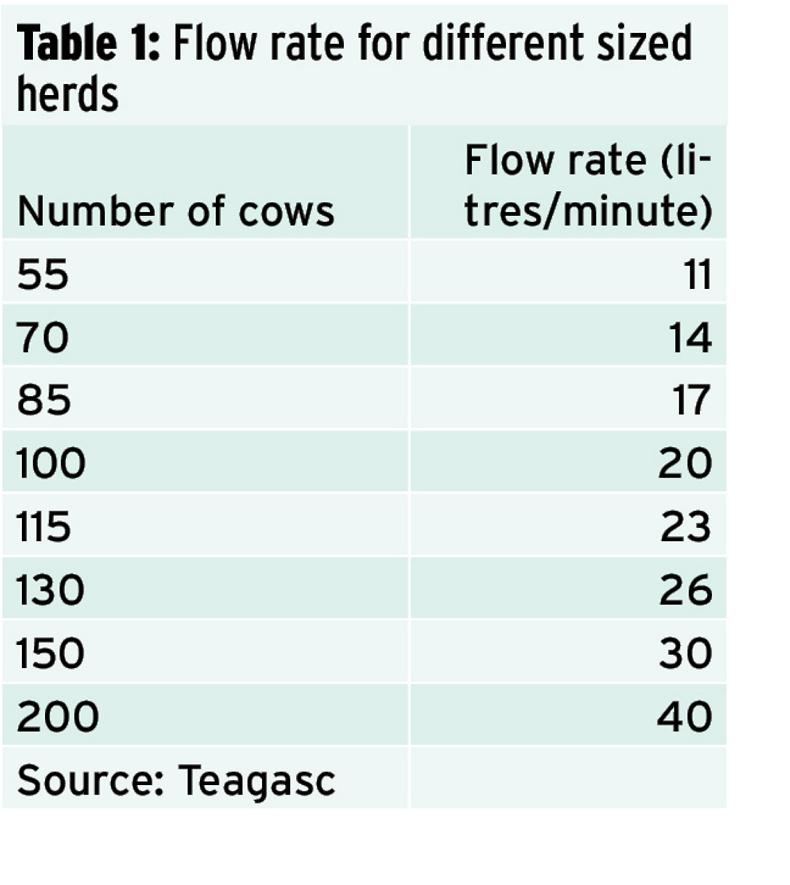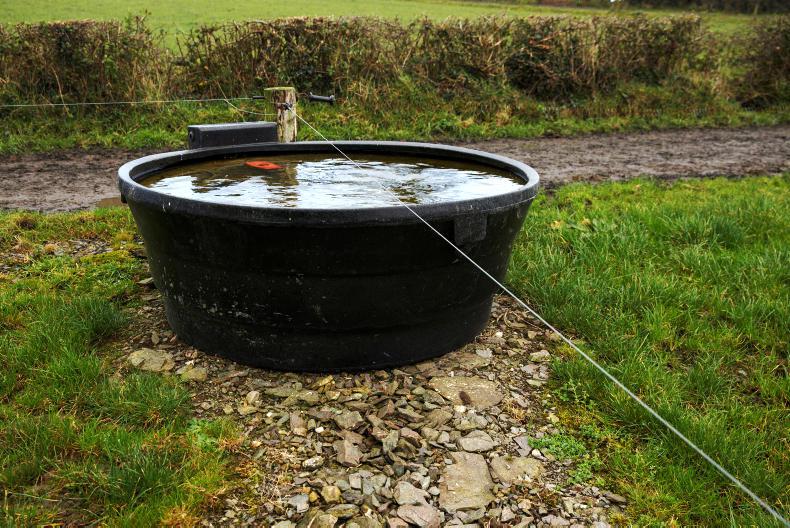When it comes to setting up a water system for your farm, one of the key decisions to be made is the size of the water pipe to use. It is recommended that the internal diameter of the pipe should be 25mm for up to 150 cows, 32mm for 150 to 300 cows and 40mm for more than 300 cows, according to Teagasc. Connections from the main line to the water trough should not be more than 50m and these connecting pipes to the main water line can be 25mm.
A cow will typically drink at a rate of 14 litres per minute and this should be factored in when deciding on what size trough to install. Dairy cows will generally consume 30-50% of their water intake within three hours of milking, consuming a total of over 70 litres a day. Water systems have to be designed to cater for the peaks in demand experienced.
The guideline is to allow nine litres of a reserve per cow in a paddock, which is equivalent to about two gallons.
There are several options that can be taken when installing water troughs. One option is to install water troughs in each paddock. A lower-cost option is to position them strategically to cater for several paddocks. This may work for temporary paddocks.
Teagasc outlines that each cow needs approximately 450mm of drinking space, measured along the trough rim. This means that 10 cows would be able to drink around a typical 110 gallon rectangular water trough that has a total length of a rim of 4.8m at one time. Where one of these troughs would be used to service two paddocks, this would be cut to five cows.
The positioning of the water trough is also important, especially for farmers who are in derogation. A change to the Nitrates Action Plan (NAP) means that farmers in derogation will be required to have drinking points at least 20m away from the watercourse, where the farm is stocked over 170kg N/ha. This is to prevent ground becoming poached which could lead to nutrients entering a nearby watercourse
Pipe system
Tom Hennessy from Terra Liquid Minerals said the majority of the queries that he gets from farmers when it comes to water systems are in relation to the trough size and what diameter pipe they should be using.
“A lot of farmers that have water issues think that getting a bigger trough is going to solve the problem but it won’t – you need the right-sized pipe feeding into it.”
I would always recommend that farmers use the three-quarter-inch pipe with a 25mm internal diameter
Large troughs can compensate a bit when it comes to a poor flow rate as it provides more drinking space for cattle, but can still leave the herd under pressure for water, especially at peak times. Another option may be to install two water troughs in paddocks. This may also be required for larger herds.
“I would never recommend farmers to use the half-inch pipe. I would always recommend that farmers use the three-quarter-inch pipe with a 25mm internal diameter. They are both the same cost to bury,” according to Tom. Prices to bury the 25mm pipe range from €1.80/m to €2.80/m excluding VAT, including the pipe itself, depending on the length of pipe that would be buried.
The cost of the pipe itself can also vary depending on the supplier but Tom outlined that in general 25mm pipe can cost 65c/m, 32mm pipe can cost 95c/m and 40mm pipe can cost €1.30/m, all excluding VAT.
“Larger farms over 120-150 acres would be lower cost than smaller farms. The less metres there are, the higher cost it is per metre to install,” Tom said.
When burying the pipe with the mole plough it is set to put it 600mm, or about 2ft deep. This keeps it safe from frost and if any arable work is carried out on the farm.
“It is all about future-proofing the farm. Even if you think that you are as large as you are going to go, you never know when land could come up around you,” Tom said. “When it comes to deciding what water trough to put in, I would generally go for the concrete troughs as I believe they are more robust. A typical 75 gallon concrete trough would cost around €125 plus VAT while a smaller 40 gallon concrete tough would cost around €100 plus VAT. The 40 gallon trough might be OK for someone with 20 to 30 suckler cows but for the larger suckler farmers or dairy farmers I would be looking at the larger troughs.”
Loop system
When installing a new water system it is strongly recommended to install a loop system where possible. By creating a loop it means that water is approaching troughs from both sides, which leads to increased pressure. This is especially useful for the furthest away troughs where water pressure might be poor. Troughs do not have to all be located directly off this main loop and can be joined by a connecting pipe while still benefiting from the extra pressure of the loop system.
When positioning the trough, it is important not to put it somewhere that will just keep the contractor happy. Place it somewhere that suits the layout of the field that cows will not have to walk significant distances to get to and that may suit the setup of temporary paddocks if necessary. When it comes to rented ground, there may be the reluctance to spend substantial amounts on grazing infrastructure so it may be an option to have one drinker to service several paddocks. However, cows must still have access to sufficient water.
The ballcock can also cause major issues with any water system and it is recommended to keep away from high pressure ballcocks as they will usually have a much poorer flow than medium or low-pressure ballcocks. The examples given by Teagasc show that a high-pressure half-inch ballcock has a flow rate of eight litres per minute whereas a medium pressure one would have a substantially higher flow rate of 32 litres per minute.
Flow rate
Calculating the flow rate can be a useful and simple exercise to determine if your water system is up to scratch. The Teagasc Dairy Farm Infrastructure handbook gives a simple procedure to check and see if the flow rate for each trough is sufficient. If we assume a daily intake of 70 litres for a dairy cow milking with approximately 50% of this consumed in the three-hour period after milking, this would give a flow rate of 12 litres/cow/hour.
This would mean that an average 100-cow herd would need a flow rate of 1,200 litres/hour or 20 litres/minute.
It is also important to be conscious to know that flow rate will not be the same for the entire farm with troughs further away maybe having less pressure.
When it comes to fattening steers or suckler cows, a flow rate of 9 litres/minute will be sufficient as the peak demand will not be the same as dairy cows, as it will not be as concentrated.

Steps to checking flow rate
The first thing to do is mark the level of the water in the trough while full.Tie up the ballcock and empty a portion of the trough. It is important that you measure how much you take out. For example take 25 litres out. Then release the ballcock and hold it down and measure the time it takes to refill to the original mark put on the trough. Divide the amount emptied out by the time taken to refill the trough. If it takes two minutes to refill then we divide the 25 litres by two which gives a flow rate of 12.5litres/minute. Calculate the demand of the herd and ensure that the system is sufficient. Read more
How much do you pay to install a paddock system?
When it comes to setting up a water system for your farm, one of the key decisions to be made is the size of the water pipe to use. It is recommended that the internal diameter of the pipe should be 25mm for up to 150 cows, 32mm for 150 to 300 cows and 40mm for more than 300 cows, according to Teagasc. Connections from the main line to the water trough should not be more than 50m and these connecting pipes to the main water line can be 25mm.
A cow will typically drink at a rate of 14 litres per minute and this should be factored in when deciding on what size trough to install. Dairy cows will generally consume 30-50% of their water intake within three hours of milking, consuming a total of over 70 litres a day. Water systems have to be designed to cater for the peaks in demand experienced.
The guideline is to allow nine litres of a reserve per cow in a paddock, which is equivalent to about two gallons.
There are several options that can be taken when installing water troughs. One option is to install water troughs in each paddock. A lower-cost option is to position them strategically to cater for several paddocks. This may work for temporary paddocks.
Teagasc outlines that each cow needs approximately 450mm of drinking space, measured along the trough rim. This means that 10 cows would be able to drink around a typical 110 gallon rectangular water trough that has a total length of a rim of 4.8m at one time. Where one of these troughs would be used to service two paddocks, this would be cut to five cows.
The positioning of the water trough is also important, especially for farmers who are in derogation. A change to the Nitrates Action Plan (NAP) means that farmers in derogation will be required to have drinking points at least 20m away from the watercourse, where the farm is stocked over 170kg N/ha. This is to prevent ground becoming poached which could lead to nutrients entering a nearby watercourse
Pipe system
Tom Hennessy from Terra Liquid Minerals said the majority of the queries that he gets from farmers when it comes to water systems are in relation to the trough size and what diameter pipe they should be using.
“A lot of farmers that have water issues think that getting a bigger trough is going to solve the problem but it won’t – you need the right-sized pipe feeding into it.”
I would always recommend that farmers use the three-quarter-inch pipe with a 25mm internal diameter
Large troughs can compensate a bit when it comes to a poor flow rate as it provides more drinking space for cattle, but can still leave the herd under pressure for water, especially at peak times. Another option may be to install two water troughs in paddocks. This may also be required for larger herds.
“I would never recommend farmers to use the half-inch pipe. I would always recommend that farmers use the three-quarter-inch pipe with a 25mm internal diameter. They are both the same cost to bury,” according to Tom. Prices to bury the 25mm pipe range from €1.80/m to €2.80/m excluding VAT, including the pipe itself, depending on the length of pipe that would be buried.
The cost of the pipe itself can also vary depending on the supplier but Tom outlined that in general 25mm pipe can cost 65c/m, 32mm pipe can cost 95c/m and 40mm pipe can cost €1.30/m, all excluding VAT.
“Larger farms over 120-150 acres would be lower cost than smaller farms. The less metres there are, the higher cost it is per metre to install,” Tom said.
When burying the pipe with the mole plough it is set to put it 600mm, or about 2ft deep. This keeps it safe from frost and if any arable work is carried out on the farm.
“It is all about future-proofing the farm. Even if you think that you are as large as you are going to go, you never know when land could come up around you,” Tom said. “When it comes to deciding what water trough to put in, I would generally go for the concrete troughs as I believe they are more robust. A typical 75 gallon concrete trough would cost around €125 plus VAT while a smaller 40 gallon concrete tough would cost around €100 plus VAT. The 40 gallon trough might be OK for someone with 20 to 30 suckler cows but for the larger suckler farmers or dairy farmers I would be looking at the larger troughs.”
Loop system
When installing a new water system it is strongly recommended to install a loop system where possible. By creating a loop it means that water is approaching troughs from both sides, which leads to increased pressure. This is especially useful for the furthest away troughs where water pressure might be poor. Troughs do not have to all be located directly off this main loop and can be joined by a connecting pipe while still benefiting from the extra pressure of the loop system.
When positioning the trough, it is important not to put it somewhere that will just keep the contractor happy. Place it somewhere that suits the layout of the field that cows will not have to walk significant distances to get to and that may suit the setup of temporary paddocks if necessary. When it comes to rented ground, there may be the reluctance to spend substantial amounts on grazing infrastructure so it may be an option to have one drinker to service several paddocks. However, cows must still have access to sufficient water.
The ballcock can also cause major issues with any water system and it is recommended to keep away from high pressure ballcocks as they will usually have a much poorer flow than medium or low-pressure ballcocks. The examples given by Teagasc show that a high-pressure half-inch ballcock has a flow rate of eight litres per minute whereas a medium pressure one would have a substantially higher flow rate of 32 litres per minute.
Flow rate
Calculating the flow rate can be a useful and simple exercise to determine if your water system is up to scratch. The Teagasc Dairy Farm Infrastructure handbook gives a simple procedure to check and see if the flow rate for each trough is sufficient. If we assume a daily intake of 70 litres for a dairy cow milking with approximately 50% of this consumed in the three-hour period after milking, this would give a flow rate of 12 litres/cow/hour.
This would mean that an average 100-cow herd would need a flow rate of 1,200 litres/hour or 20 litres/minute.
It is also important to be conscious to know that flow rate will not be the same for the entire farm with troughs further away maybe having less pressure.
When it comes to fattening steers or suckler cows, a flow rate of 9 litres/minute will be sufficient as the peak demand will not be the same as dairy cows, as it will not be as concentrated.

Steps to checking flow rate
The first thing to do is mark the level of the water in the trough while full.Tie up the ballcock and empty a portion of the trough. It is important that you measure how much you take out. For example take 25 litres out. Then release the ballcock and hold it down and measure the time it takes to refill to the original mark put on the trough. Divide the amount emptied out by the time taken to refill the trough. If it takes two minutes to refill then we divide the 25 litres by two which gives a flow rate of 12.5litres/minute. Calculate the demand of the herd and ensure that the system is sufficient. Read more
How much do you pay to install a paddock system?











SHARING OPTIONS